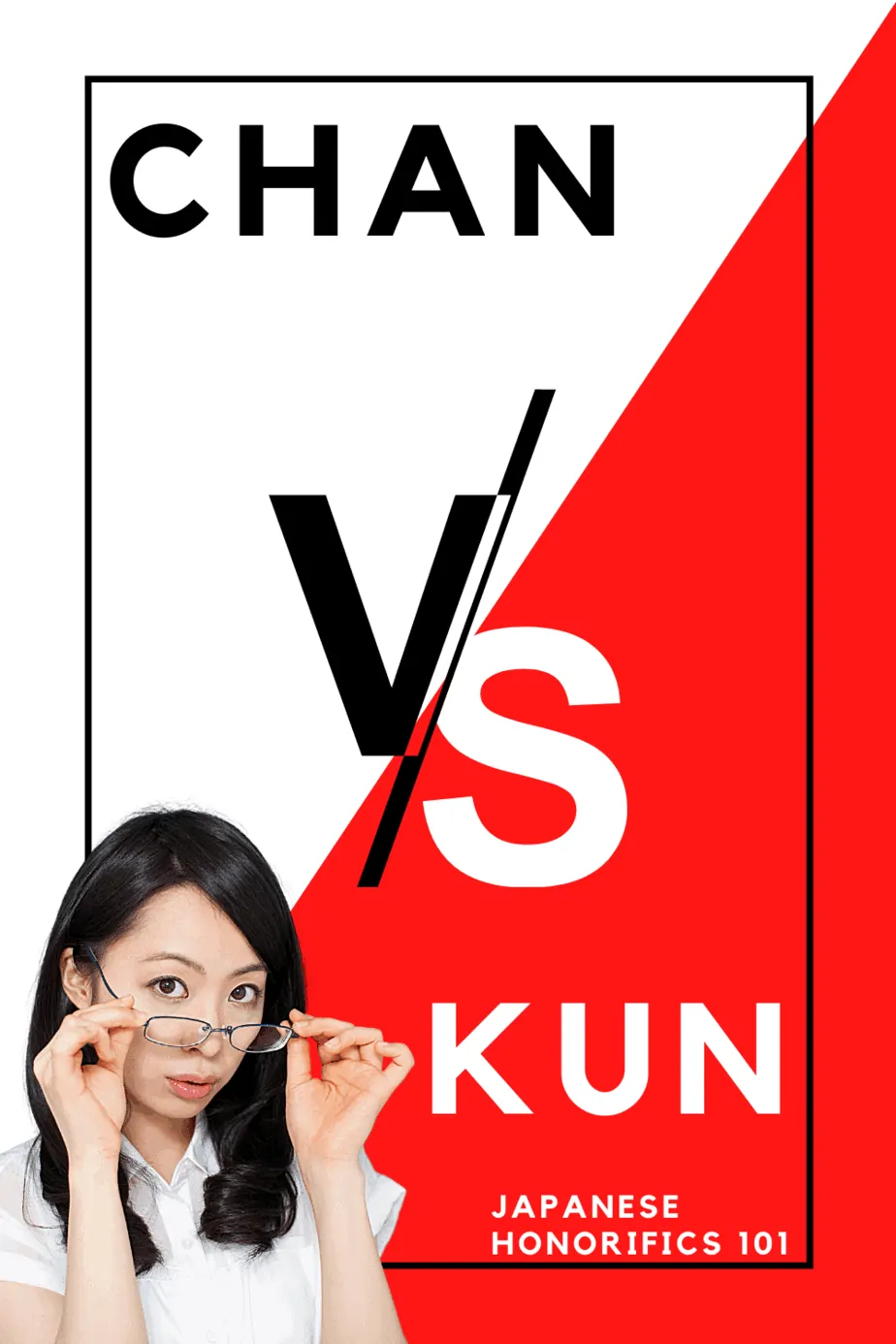Feeling a little like channeling your inner child? Japanese name enders —ちゃん(“chan”) and —くん (“kun”) are two great additions to anyone’s Japanese vocabulary bank.
These two words are a type of suffix you can add to someone’s name to communicate a range of information.
Today, we’ll give you a rundown on these two words, and also where they fall in the “ecosystem” of the Japanese language. But first, let’s start simple…

What is the difference between chan vs kun?
Chan (ちゃん) and kun (くん) are Japanese name enders (suffixes) with some subtle difference. Kun is typically (though not exclusively) used with males, and usually is used by an older person to refer to a younger one, and can also be used imply closeness between friends. Chan expresses a sense of finding the other person “sweet,” or cute, and so can also be used to communicate closeness. Kun is somewhat safe in a business environment, while chan is less likely to be appropriate.
Japanese suffixes — in general
In English, most people will use Mr./Mrs./Ms. on business occasions or first encounters.
The same is not true for Japanese.
Be it their given, sur, or full name, in Japanese, names are almost always followed up with an “honorific” name ender.
I put “honorific” in quotes because while that’s what this class of word is most often called in English, it doesn’t really cover the nature of things in Japanese since the words don’t convey “honor” in the way we think of it in English.
Would you call “Mr.” and honorific? How about “bro”?
In Japanese these types of words are called setsubishi or <setsubigo and are written as either 接尾詞, 接尾辞, or 接尾語.
These three character words all roughly mean “adjoining-end-word”—aka, a suffix.
And, as such, they can be used to convey far more than honor. They’re used to convey respect, politeness, friendship, intimacy, judgement, disdain, and more.
However, since the word “honorific” gets used so often, I’ll be using both “suffix” and “honorific” interchangeably in this article.
Japanese names — in general
One important thing to note about Japanese names is that they are said in the reverse of what we expect in English. The Japanese give their names last then first.
How the names are used is similar to what we expect in English, though slightly more rigid.
Calling someone by their last name implies distance, calling them by their first name implies closeness. Suffixes are then added on to this in order to add nuance.
Typically, in Japanese, you will always call someone by their last name, even a peer, until they let you do otherwise.
In this article, I will be writing names in the Japanese way.
So, to give a few famous examples, I’d be writing names like: Pitt Brad, Cruise Tom, Statham Jason, and Radcliff Daniel.
How to choose a Japanese honorific/suffix
Your choice of suffix depends on your relationship to the person you are addressing.
Selecting the wrong honorific may open a can of worms—leading to humiliation, hurt feelings, embarrassment, and/or your being canned from that dream job working in Japan.
Japanese has several essential name enders. Among the most important to learn are —さん (“san”), —ちゃん (“chan”), and —くん (“kun”).
These name enders not only apply to humans, but can also be used for animals, concepts, place names, job descriptions, and even inanimate objects!
While there are a few general rules of use—which I shall go into detail on—these three name enders will cover you in most situations.
While this is primarily an article discussing chan vs kun, we need to dive into the most common and vital Japanese suffix before we can continue.
Chan and kun make the most sense in the context of the other common expressions.
さん (San)
This is the go-to suffix. Virtually everyone you meet you will call -san right away. This goes for men and women alike. Let’s take a look at an example.
I have a co-worker named Kunamoto Shizaka. If we are at work, I will normally address her as Kunamoto-san.
When the company throws a seasonal 宴会 (“enkai”), or work party, I might loosen things up and go with the more casual “Shizaka-san.”
In English we sometimes use Mr./Mrs./Ms. When talking about characters—like Mr. Potato head for example.
This happens a lot in Japanese.
A person might call a tiger in the zoo 虎さん (“tora-san”) or Mr./Ms Tiger. The company you have business with, ABC company for example, can also get a —san tacked on: ABCさん (“ABC-san”).
Someone might also introduce themself using their company name, therefore taking on the identity of the company itself.
Chan (ちゃん)
At last we arrive at chan. This suffix is directly related to san, and is actually a sort of mutated version of it. When toddlers—just first learning to speak—try to pronounce “san,” it comes out as “chan.”
This childish way of saying “san” eventually took on a “cutesy” feel and made its way into the broader Japanese language.
Chan is cute. It’s affectionate. And it’s versatile!
The most common use is with female children, who are often addressed with chan at the end of their given names.
Adults, too, address each other with chan when they are close friends.
In this case, even men might be called chan, which would carry a strong endearing sense with it. Even inanimate objects sometimes carry the chan in conversation, especially if it’s cute.
While usually it is used to address others, some young women find it entertaining to refer to themselves using their given name + chan when in conversation with their friends.
This gives the appearance of cuteness with a dash of childishness.
For family members whom you are quite close with, it is quite common to address them using their kinship title -chan, especially if you’re feeling warmly towards them.
Nicknames for your older sister, your お姉さん (“onee-san”), include お姉ちゃん (“o-nee-chan”), and made even more informal by taking off the honorific お- (“o”) 姉ちゃん (“nee-chan”).
Your grandmother and grandfather might be おばあちゃん (“obaa-chan”) or おじいちゃん (“ojii-chan”) respectively.
Remember Kunamoto Shizaka at the work party? Well, let’s imagine you fancy her and want to get a little flirtatious. When she tops off your beer, thank her as “Shizaka-chan,” and check for blushing!
The neighbor’s dog,Toro? Adults and children alike call him トロ—ちゃん (“toro—chan”)!
Arnold Schwarzenegger? His name is a bit of a tongue twister in Japanese: アーノルド・シュワルツェネッガー (“aanorudo shuwarutseneggaa”) and so was shortened down to the rather charming シュワちゃん (“shuwa-chan”)!
Now for something to avoid. Don’t address your boss with -chan or anyone higher on the workplace totem pole.
Furthermore, it is viewed as condescending when a woman is addressed with -chan by someone in a position of authority over her. By using -chan rather than -san, the speaker is speaking down to the female worker.
The further diminution of chan
While chan is baby-talk for san, there’s actually even more babified forms of chan! Tan and chin are the extra-cutesy way of saying chan. You won’t hear these very often outside of the especially adorable.
One particularly famous example of tan might be familiar to fan of the English language HBO show, “Last Week Tonight with John Oliver.”
In that story, a rather adorable Japanese macot by the name of ちぃたん (“chi-tan”) shot to the front pages worldwide after it’s feud with another town mascot しんじょくん (“shinjo-kun”) featured on CNN and “Last Week Tonight with John Oliver.”
Chi-tan is a 0-year-old fairy baby with a bit of a bad behavior problem while Shinjo-kun is an otter.
Kun (くん)
Unlike chan, kun came into its own from a different part of the language. Kun finds its origin in the common pronoun “kimi” (君; きみ).
While kimi itself has gone through many changes in the modern era, nowadays it’s a rather casual way to say “you.” Kun, similarly, is fairly casual.
Kun is written in either hiragana ,くん, or with the chinese character, 君. It is a more casual honorific than san and can follow a full name, given name, or family name. More often than not it is reserved for boys or men.
That said, when it comes to formal, or business related situations, older males of senior status may address younger female employees as kun, implying respectful endearment.
Let’s return to Shizaka. Let’s say that you wanted to make her feel like she’s been doing a good job in her new position and want her to feel respected and included in the work environment.
Now she becomes Shizaka-kun.
As with chan, you shouldn’t use this honorific with someone of higher status than yourself. This is true except for rare circumstances.
One such rare example is at Keio University.
Founded in the 19th century by Fukuzawa Yukichi, who studied at Brown, this university follows his belief that since learning is a continuous process, there should be no hierarchy between teachers and students, since they are all learners.
So, all teachers are referred to with kun.
The final word on name finalizers
So, what’s the difference between chan vs kun?
While they both are used for peers or those of lower status than the speaker, chan carries a stronger sense of “cuteness” and/or endearment (and is most common, though not exclusive, among females), while kun can still convey respect and is most common (again, but not exclusive) among males.
Thanks for reading, Reader-kun! Remember, you’re always safe with san. Save kun and chan for when you really know someone well!
Related questions
Why do japanese say sama?
Sama is another very common suffix, and one that can properly be called an “honorific.” Sama is used for people of much higher status than you, as well as customers. Misusing sama can also come across as rude, similar to how it can be rude to say ma’am in the wrong way in English.
Is dono higher than sama?
In olden days, dono was higher than sama, used for very high ranking officials and nobles. Nowadays it has a wide variety of uses, although almost exclusively in writing.

Hey fellow Linguaholics! It’s me, Marcel. I am the proud owner of linguaholic.com. Languages have always been my passion and I have studied Linguistics, Computational Linguistics and Sinology at the University of Zurich. It is my utmost pleasure to share with all of you guys what I know about languages and linguistics in general.

